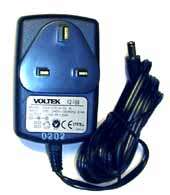|
| ||
Tell me about plug-top Power Supply UnitsTell me about Wall Warts
Firstly, you must label them before use so you know which equipment they match. I label mine using a "Ptouch" hand-held label printer. If these fall off (because of heat or plasticiser exuding from the material) then I glue them back on with "Bostick" or similar. I have also used "masking tape". The key points to note when choosing a PSU are:
The current rating should be equal to at least the maximum that the equipment will require. It does not matter if it is rated higher, except that you will probably be paying a little more for capability that you don't need. (Think of it as buying a bucket that is larger than you will ever need.) This is often labelled as a WATT or VA rating. Watts = Volts x Amps so, for example, a 12 volt power supply unit with a rating of 24 Watts (or labelled "24VA") will be able to supply 24/12 = 2 Amps of current. Some people refer to a PSU (Power Supply Unit) as "a transformer". Nowadays this is seldom correct, although the unit might contain a transformer as part of its circuit. A transformer passes only AC. Modern Power Supply Units are of a type called "Switch-Mode". They contain a bridge-rectifier (to convert AC to high-ripple DC) and a capacitor (to smooth out the ripple). This "raw DC" is then fed to the electronic switching circuit that "chops" the voltage at high frequency at around 350 volts. The resultant spikes are fed into a tiny transformer that changes the voltage to one or more lower voltages (which are still high frequency pulses). Then a rectifier and capacitor smoothes out the pulse chain into a DC voltage. Finally, if a steady (regulated) voltage is required, the current is passed through a voltage regulator circuit that removes any fluctuations. The reason for using a "Switch-Mode" PSU is that it is more efficient (wastes less power as heat) and physically smaller than a conventional PSU that used a transformer capable of running only at 50 Hz. SAFETYAs these units might present a risk of fire, keep them away from curtains, furniture and carpets. If the unit is separate from the plug, place it on a ceramic tile or plate. Keep it cool. Do not place anything on top of it. | ||
| Send this page address - CLICK HERE - to a friend ! | ||

